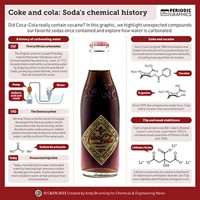Advertisement
Grab your lab coat. Let's get started
Welcome!
Welcome!
Create an account below to get 6 C&EN articles per month, receive newsletters and more - all free.
It seems this is your first time logging in online. Please enter the following information to continue.
As an ACS member you automatically get access to this site. All we need is few more details to create your reading experience.
Not you? Sign in with a different account.
Not you? Sign in with a different account.
ERROR 1
ERROR 1
ERROR 2
ERROR 2
ERROR 2
ERROR 2
ERROR 2
Password and Confirm password must match.
If you have an ACS member number, please enter it here so we can link this account to your membership. (optional)
ERROR 2
ACS values your privacy. By submitting your information, you are gaining access to C&EN and subscribing to our weekly newsletter. We use the information you provide to make your reading experience better, and we will never sell your data to third party members.
Environment
Newscripts
McDonald's thinks outside the nanobox, Elemental advertising, Smell recorder, Melt-resistant chocolate
by Rachel Sheremeta Pepling
August 21, 2006
| A version of this story appeared in
Volume 84, Issue 34
McDonald's thinks outside the nanobox
Big Macs may start coming with small packaging at a McDonald's near you. Nanotech Buzz, a nanotechnology weblog, reports that the burger conglomerate recently made a deal with Ecosynthetix. The Lansing, Mich.-based adhesives company will supply the Golden Arches chain with nanotechnology-based packaging.
Ecosynthetix's nanoparticle adhesives will replace the polyvinyl acetate and polyvinyl alcohol currently used to affix graphics onto McDonald's familiar cardboard "clamshell" containers. The adhesives—which use crop—based starches rather than traditional petroleum-based ones-will also be used to glue the paper layers of the corrugated boxes together.
Elemental advertising
Chemistry truly is everywhere you turn. And apparently it's a useful advertising tool.
Caryn Allender, an American Chemical Society employee, was recently visiting the Karen Radley Acura car dealership in Woodbridge, Va., when she came across an advertisement incorporating elements of the periodic table. Actinium, uranium, and radium—complete with atomic number and molecular weight information—were borrowed to spell out AcURa. The tag line: "It's time for your Acura's periodic checkup."
Maybe science sells. Perhaps you, dear Newscripts readers, have had interesting elemental sightings of your own. Feel free to send in your tales and photos of elemental ads to newscripts@acs.org.
Smell recorder
Smell-o-vision may be one step closer to reality. NewScientist.com news service reported on June 29 that engineers at Tokyo Institute of Technology, in Japan, are building a recorder capable of capturing and replaying smells, just as we currently do with sounds and images.
The recorder will use 15 chemical microchips to capture a wide range of aromas that are used to create "a digital recipe" from 96 chemicals. To replay an aroma, the appropriate chemicals are mixed, heated, and vaporized. According to NewScientist.com, the device has successfully recorded and replayed the scents of an orange, a lemon, an apple, a banana, and a melon.
No word, however, on when the smell recorder will be available.
Melt-resistant chocolate
With scorching temperatures across the U.S. earlier this month, no chocolate bar stood a chance of weathering the heat. Food scientists at the Cocoa Research Institute of Nigeria, in Ibadan, are well aware of chocolate's weakness in heat. Ironically, most brands of chocolate melt readily in tropical climates, limiting distribution of the confection in the very countries that produce cocoa beans. The food scientists, however, may have developed a solution to this sticky situation.
Most chocolates melt into a gooey mess anywhere between 77 and 86 °F (25-30 °C). The researchers, who published their findings in the July issue of the British Food Journal (2006, 108, 451), attribute chocolate's melting point to the softening of cocoa butter—the natural fat of the cocoa bean—which occurs around 86 to 90 °F (30-32 °C).
By mixing cornstarch with the cocoa (about 10% starch), the researchers extended chocolate's melting point to 122 °F (50 °C). Adding gelatin increased the melting point to 113 °F (45 °C). They posit that the starch and gelatin act as thickening agents, each preventing cocoa butter from outflowing within the chocolate mass.
However, and perhaps most important here, chocolate mixed with cornstarch compared favorably taste-wise with conventional milk chocolate during a sensory evaluation, more so than the chocolate mixed with gelatin.





Join the conversation
Contact the reporter
Submit a Letter to the Editor for publication
Engage with us on Twitter